数据结构开发(16):选择排序和插入排序
0.目录
1.排序的基本概念
2.选择排序
3.插入排序
4.小结
1.排序的基本概念
排序的一般定义:
- 排序是计算机内经常进行的一种操作,其目的是将一组“无序”的数据元素调整为“有序”的数据元素。

排序的数学定义:
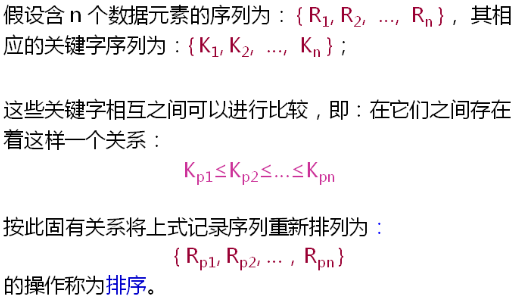
排序的示例:
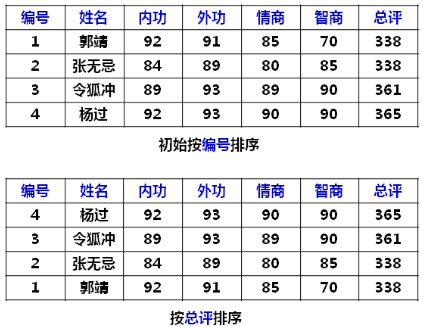
问题:
- 按总评排序后为什么张无忌的排名比郭靖靠前呢?
排序的稳定性:

稳定性排序示例:
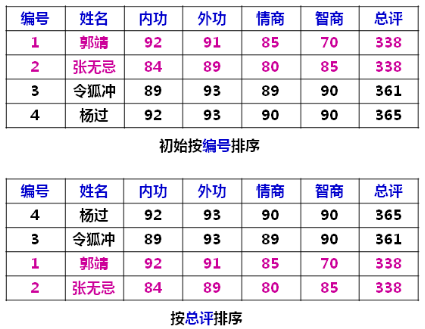
多关键字排序:
- 排序时需要比较的关键字多余一个
- 排序结果首先按关键字1进行排序
- 当关键字1相同时按关键字2进行排序
- ......
- 当关键字n-1相同时按关键字n进行排序
多关键字排序示例:
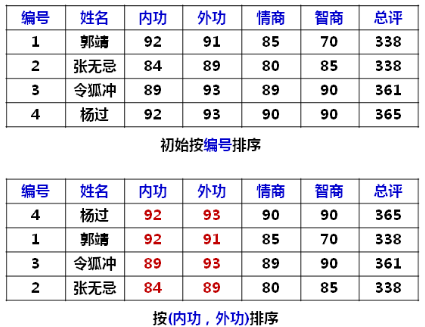
问题:
- 多关键字排序是否比单关键字排序更复杂?
对于多关键字排序,只需要在比较操作时同时考虑多个关键字即可!!
演示多关键字的比较:
#include <iostream>
#include "Object.h"
using namespace std;
using namespace StLib;
struct Test : public Object
{
int key1;
int key2;
Test(int k1, int k2)
{
key1 = k1;
key2 = k2;
}
bool operator == (const Test& t)
{
return (key1 == t.key1) && (key2 == t.key2);
}
bool operator != (const Test& t)
{
return !(*this == t);
}
bool operator < (const Test& t)
{
return (key1 < t.key1) || ((key1 == t.key1) && (key2 < t.key2));
}
bool operator >= (const Test& t)
{
return !(*this < t);
}
bool operator > (const Test& t)
{
return (key1 > t.key1) || ((key1 == t.key1) && (key2 > t.key2));
}
bool operator <= (const Test& t)
{
return !(*this > t);
}
};
int main()
{
Test t1(3, 4);
Test t2(2, 5);
Test t3(3, 5);
cout << "(t1 > t2) : " << (t1 > t2) << endl;
cout << "(t1 > t3) : " << (t1 > t3) << endl;
return 0;
}
运行结果为:
(t1 > t2) : 1
(t1 > t3) : 0
排序中的关键操作:
- 比较
- 任意两个数据元素通过比较操作确定先后次序
- 交换
- 数据元素之间需要交换才能得到预期结果
排序的审判:
- 时间性能
- 关键性能差异体现在比较和交换的数量
- 辅助存储空间
- 为完成排序操作需要的额外的存储空间
- 必要时可以“空间换时间”
- 算法的实现复杂性
- 过于复杂的排序法可能影响可读性和可维护性
StLib中的排序类设计:

定义StLib中的排序类(Sort.h):
#ifndef SORT_H
#define SORT_H
#include "Object.h"
namespace StLib
{
class Sort : public Object
{
private:
Sort();
Sort(const Sort&);
Sort& operator = (const Sort&);
template <typename T>
static void Swap(T& a, T&b)
{
T c(a);
a = b;
b = c;
}
public:
};
}
#endif // SORT_H
2.选择排序
选择排序的基本思想:

第 i 次选择排序示例:

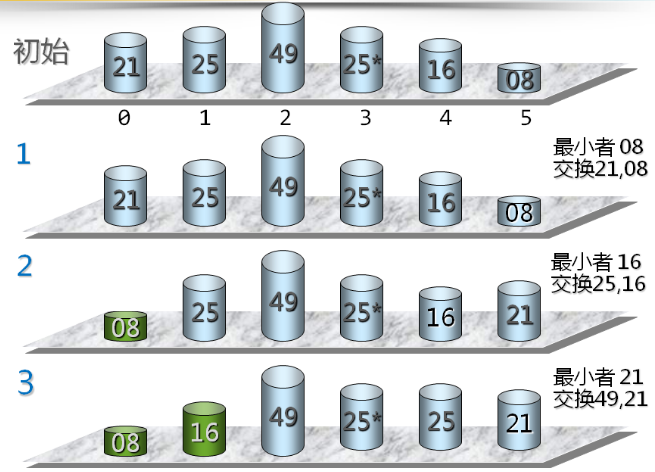
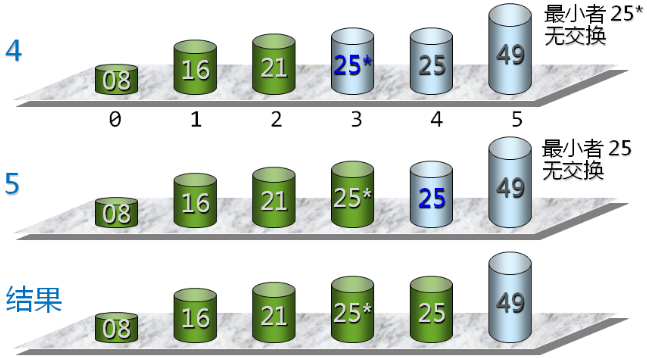
实现选择排序(在Sort.h中):
public:
template <typename T>
static void Select(T array[], int len, bool min2max = true)
{
for(int i=0; i<len; i++)
{
int min = i;
for(int j=i+1; j<len; j++)
{
if( min2max ? (array[min] > array[j]) : (array[min] < array[j]) )
{
min = j;
}
}
if( min != i )
{
Swap(array[i], array[min]);
}
}
}
main.cpp测试:
#include <iostream>
#include "Sort.h"
using namespace std;
using namespace StLib;
int main()
{
int array[] = {3, 1, 2, 5, 4};
Sort::Select(array, 5);
for(int i=0; i<5; i++)
{
cout << array[i] << endl;
}
cout << "~~~" << endl;
Sort::Select(array, 5, false);
for(int i=0; i<5; i++)
{
cout << array[i] << endl;
}
return 0;
}
运行结果为:
1
2
3
4
5
~~~
5
4
3
2
1
3.插入排序
插入排序的基本思想:

第 i 次插入排序示例:
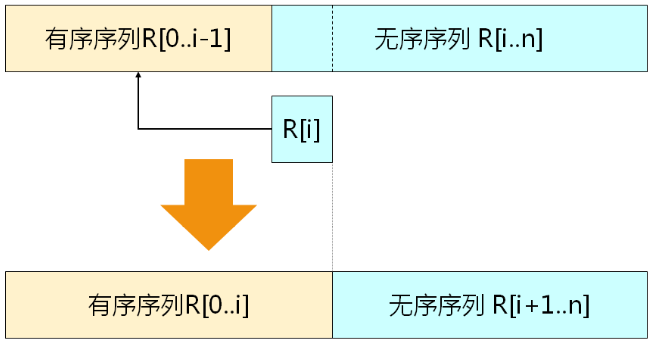



实现插入排序(在Sort.h中):
public:
template <typename T>
static void Insert(T array[], int len, bool min2max = true) // 一边比较一边移动
{
for(int i=1; i<len; i++)
{
int k = i;
T e = array[i];
for(int j=i-1; (j>=0) && (min2max ? (array[j]>e) : (array[j]<e)); j--)
{
array[j+1] = array[j];
k = j;
}
if( k != i )
{
array[k] = e;
}
}
}
mian.cpp测试:
#include <iostream>
#include "Sort.h"
using namespace std;
using namespace StLib;
int main()
{
int array[] = {3, 1, 2, 5, 4};
Sort::Insert(array, 5);
for(int i=0; i<5; i++)
{
cout << array[i] << endl;
}
cout << "~~~" << endl;
Sort::Insert(array, 5, false);
for(int i=0; i<5; i++)
{
cout << array[i] << endl;
}
return 0;
}
运行结果为:
1
2
3
4
5
~~~
5
4
3
2
1
4.小结
- 排序是数据元素从无序到有序的过程
- 排序具有稳定性,是选择排序算法的因素之一
- 比较和交换是排序的基本操作
- 多关键字排序与单关键字排序无本质区别
- 排序的时间性能是区分排序算法好坏的主要因素
- 选择排序每次选择未排元素中的最小元素
- 插入排序每次将第 i 个元素插入前面 i-1 个已排元素中
- 选择排序是不稳定的排序法,插入排序是稳定的排序方法
- 选择排序和插入排序的时间复杂度为 O(n²)


【推荐】还在用 ECharts 开发大屏?试试这款永久免费的开源 BI 工具!
【推荐】国内首个AI IDE,深度理解中文开发场景,立即下载体验Trae
【推荐】编程新体验,更懂你的AI,立即体验豆包MarsCode编程助手
【推荐】轻量又高性能的 SSH 工具 IShell:AI 加持,快人一步